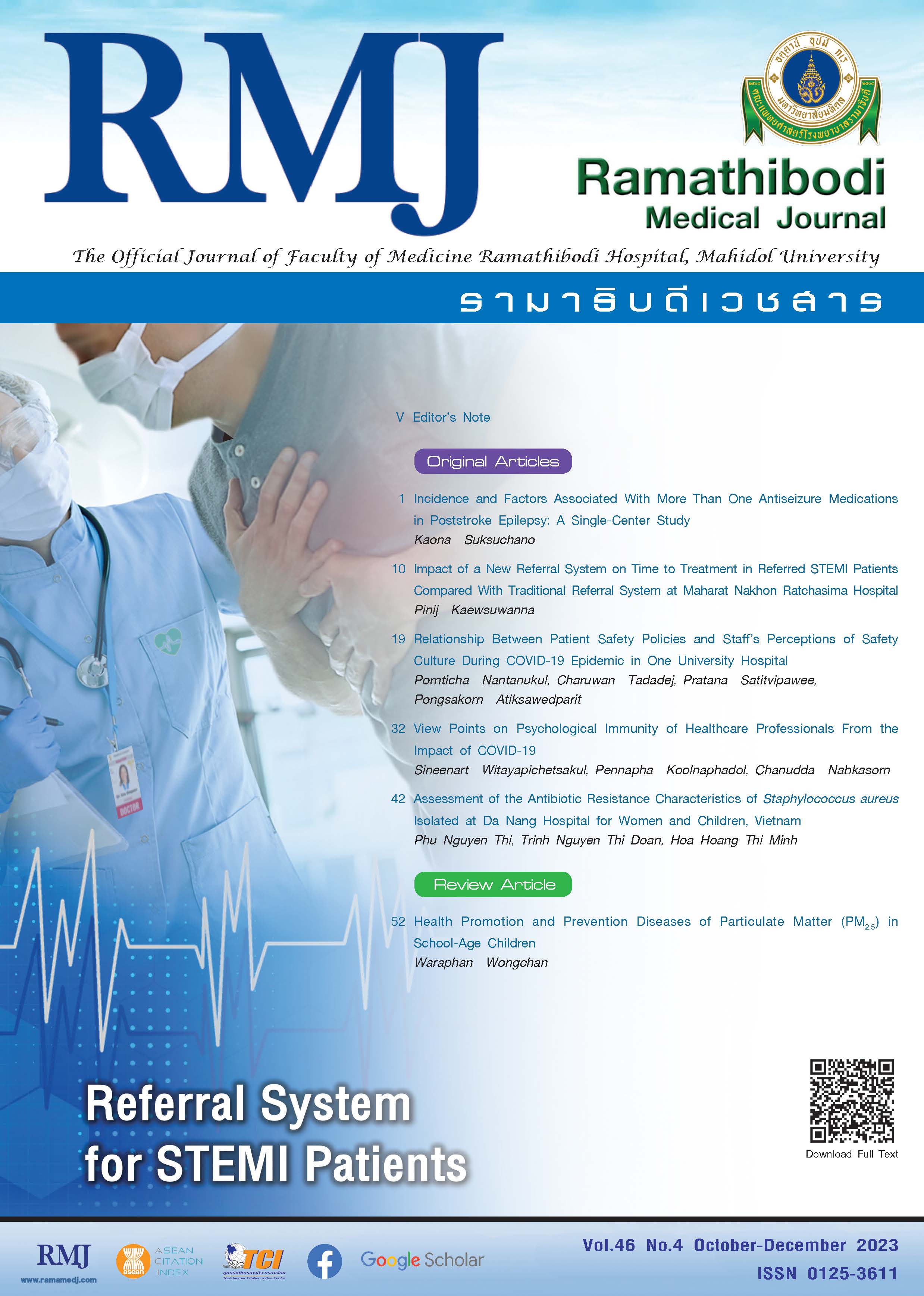Incidence and Factors Associated With More Than One Antiseizure Medications in Poststroke Epilepsy: A Single-Center Study
DOI:
https://doi.org/10.33165/rmj.2023.46.4.265368Keywords:
Poststroke epilepsy, Antiseizure medication, Associated factors, Drug resistant epilepsyAbstract
Background: People with epilepsy are burdened with consequence of seizures, especially in drug resistant epilepsy. However, patients with poststroke epilepsy (PSE) who were mostly elderly and faced more seizures were affected not only by functional decline but also had no abundant time for antiseizure medication (ASM) trials.
Objective: To assess the incidence and factors associated with more than one ASMs in patients with PSE.
Methods: A retrospective chart review study was evaluated in 136 patients with a stroke onset following seizure with admission, who fulfilled the poststroke epilepsy diagnosis from January 2016 to June 2023. Then, they were categorized into only one and more than one ASMs groups to analyze.
Results: The incidence rate of patients with more than one ASMs in PSE was 89.0 persons and drug resistant PSE was 16.7 persons/1000 person-years. The median time to follow was 30 months and seizure latency was 7 months. The hemorrhagic stroke type was a factor associated with more than one ASMs compared with ischemic stroke (OR, 2.77; 95% CI, 1.23 - 6.23; P = .01). There was a multicollinearity effect in hemorrhagic stroke with cranial surgery during stroke events and underlying atrial fibrillation.
Conclusions: More than one ASMs in patients with PSE were applied in neurological practices per the incidence. Moreover, the hemorrhagic stroke was found to be associated with more than one ASMs.
References
Thijs RD, Surges R, O’Brien TJ, Sander JW. Epilepsy in adults. Lancet. 2019;393(10172):689-701. doi:10.1016/S0140-6736(18)32596-0
Devinsky O, Spruill T, Thurman D, Friedman D. Recognizing and preventing epilepsy-related mortality: a call for action. Neurology. 2016;86(8):779-786. doi:10.1212/WNL.0000000000002253
Yoshimura H, Tanaka T, Fukuma K, et al. Impact of seizure recurrence on 1-year functional outcome and mortality in patients with poststroke epilepsy. Neurology. 2022;99(4):e376-e384. doi:10.1212/WNL.0000000000200609
Galovic M, Döhler N, Erdélyi-Canavese B, et al. Prediction of late seizures after ischaemic stroke with a novel prognostic model (the SeLECT score): a multivariable prediction model development and validation study. Lancet Neurol. 2018;17(2):143-152. doi:10.1016/S1474-4422(17)30404-0
Haapaniemi E, Strbian D, Rossi C, et al. The CAVE score for predicting late seizures after intracerebral hemorrhage. Stroke. 2014;45(7):1971-1976. doi:10.1161/STROKEAHA.114.004686
Krumholz A, Wiebe S, Gronseth GS, et al. Evidence-based guideline: management of an unprovoked first seizure in adults: report of the guideline development subcommittee of the American Academy of Neurology and the American Epilepsy Society. Epilepsy Curr. 2015;15(3):144-152. doi:10.5698/1535-7597-15.3.144
Brott T, Adams HP Jr, Olinger CP, et al. Measurements of acute cerebral infarction: a clinical examination scale. Stroke. 1989;20(7):864-870. doi:10.1161/01.str.20.7.864
Semah F, Picot MC, Adam C, et al. Is the underlying cause of epilepsy a major prognostic factor for recurrence? Neurology. 1998;51(5):1256-1262. doi:10.1212/wnl.51.5.1256
Burneo JG, Antaya TC, Allen BN, Belisle A, Shariff SZ, Saposnik G. The risk of new-onset epilepsy and refractory epilepsy in older adult stroke survivors. Neurology. 2019;93(6):e568-e577. doi:10.1212/WNL.0000000000007895
Lattanzi S, Rinaldi C, Cagnetti C, et al. Predictors of pharmaco-resistance in patients with post-stroke epilepsy. Brain Sci. 2021;11(4):418. doi:10.3390/brainsci11040418
de Greef BT, Schreuder FH, Vlooswijk MC, et al. Early seizures after intracerebral hemorrhage predict drug-resistant epilepsy. J Neurol. 2015;262(3):541-546. doi:10.1007/s00415-014-7592-4
Kwan P, Arzimanoglou A, Berg AT, et al. Definition of drug resistant epilepsy: consensus proposal by the ad hoc Task Force of the ILAE Commission on Therapeutic Strategies. Epilepsia. 2010;51(6):1069-1077. doi:10.1111/j.1528-1167.2009.02397.x
Scheffer IE, Berkovic S, Capovilla G, et al. ILAE classification of the epilepsies: position paper of the ILAE Commission for Classification and Terminology. Epilepsia. 2017;58(4):512-521. doi:10.1111/epi.13709
Ferlazzo E, Gasparini S, Beghi E, et al. Epilepsy in cerebrovascular diseases: review of experimental and clinical data with meta-analysis of risk factors. Epilepsia. 2016;57(8):1205-1214. doi:10.1111/epi.13448
Lattanzi S, Trinka E, Turcato G, et al. Latency of poststroke epilepsy can predict drug resistance. Eur J Neurol. 2022;29(8):2481-2485. doi:10.1111/ene.15408
Doria JW, Forgacs PB. Incidence, implications, and management of seizures following ischemic and hemorrhagic stroke. Curr Neurol Neurosci Rep. 2019;19(7):37. doi:10.1007/s11910-019-0957-4
Passero S, Rocchi R, Rossi S, Ulivelli M, Vatti G. Seizures after spontaneous supratentorial intracerebral hemorrhage. Epilepsia. 2002;43(10):1175-1180. doi:10.1046/j.1528-1157.2002.00302.x
Peter-Derex L, Philippeau F, Garnier P, et al. Safety and efficacy of prophylactic levetiracetam for prevention of epileptic seizures in the acute phase of intracerebral haemorrhage (PEACH): a randomised, double-blind, placebo-controlled, phase 3 trial. Lancet Neurol. 2022;21(9):781-791. doi:10.1016/S1474-4422(22)00235-6
Gilad R, Boaz M, Dabby R, Sadeh M, Lampl Y. Are post intracerebral hemorrhage seizures prevented by anti-epileptic treatment? Epilepsy Res. 2011;95(3):227-231. doi:10.1016/j.eplepsyres.2011.04.002
Angriman F, Tirupakuzhi Vijayaraghavan BK, Dragoi L, Lopez Soto C, Chapman M, Scales DC. Antiepileptic drugs to prevent seizures after spontaneous intracerebral hemorrhage: a systematic review and meta-analysis. Stroke. 2019;50(5):1095-1099. doi:10.1161/STROKEAHA.118.024380
Greenberg SM, Ziai WC, Cordonnier C, et al. 2022 guideline for the management of patients with spontaneous intracerebral hemorrhage: a guideline from the American Heart Association/American Stroke Association. Stroke. 2022;53(7):e282-e361. doi:10.1161/STR.0000000000000407
Tomari S, Tanaka T, Ihara M, et al. Risk factors for post-stroke seizure recurrence after the first episode. Seizure. 2017;52:22-26. doi:10.1016/j.seizure.2017.09.007
Lahti AM, Saloheimo P, Huhtakangas J, et al. Poststroke epilepsy in long-term survivors of primary intracerebral hemorrhage. Neurology. 2017;88(23):2169-2175. doi:10.1212/WNL.0000000000004009
Sinka L, Abraira L, Imbach LL, et al. Association of mortality and risk of epilepsy with type of acute symptomatic seizure after ischemic stroke and an updated prognostic model. JAMA Neurol. 2023;80(6):605-613. doi:10.1001/jamaneurol.2023.0611
Feyissa AM, Hasan TF, Meschia JF. Stroke-related epilepsy. Eur J Neurol. 2019;26(1):18-e3. doi:10.1111/ene.13813.
Stephen LJ, Kwan P, Brodie MJ. Does the cause of localization-related epilepsy influence the response to antiepileptic drug treatment? Epilepsia. 2001;42(3):357-362. doi:10.1046/j.1528-1157.2001.29000.x
Tanaka T, Fukuma K, Abe S, et al. Antiseizure medications for post-stroke epilepsy: a real-world prospective cohort study. Brain Behav. 2021;11(9):e2330. doi:10.1002/brb3.2330
Brigo F, Lattanzi S, Zelano J, et al. Randomized controlled trials of antiepileptic drugs for the treatment of post-stroke seizures: a systematic review with network meta-analysis. Seizure. 2018;61:57-62. doi:10.1016/j.seizure.2018.08.001
Downloads
Published
How to Cite
Issue
Section
License
Copyright (c) 2023 Ramathibodi Medical Journal

This work is licensed under a Creative Commons Attribution-NonCommercial-NoDerivatives 4.0 International License.

















